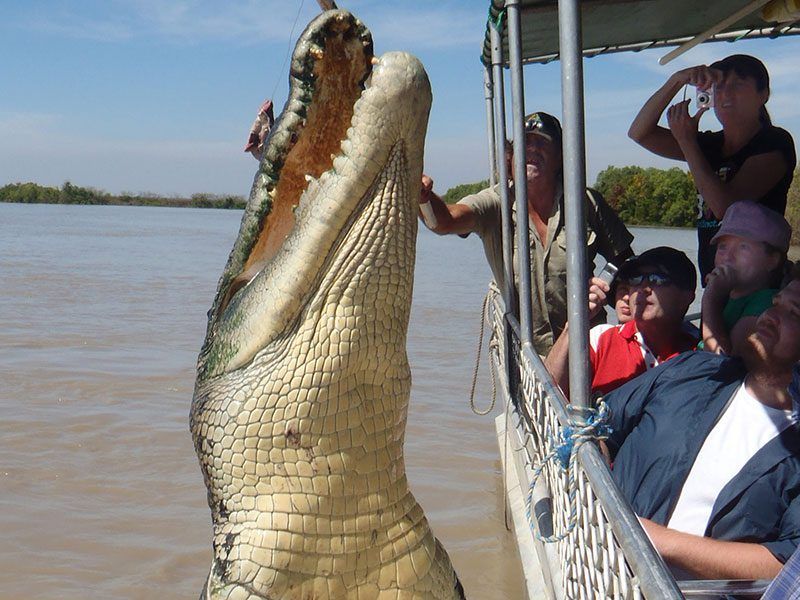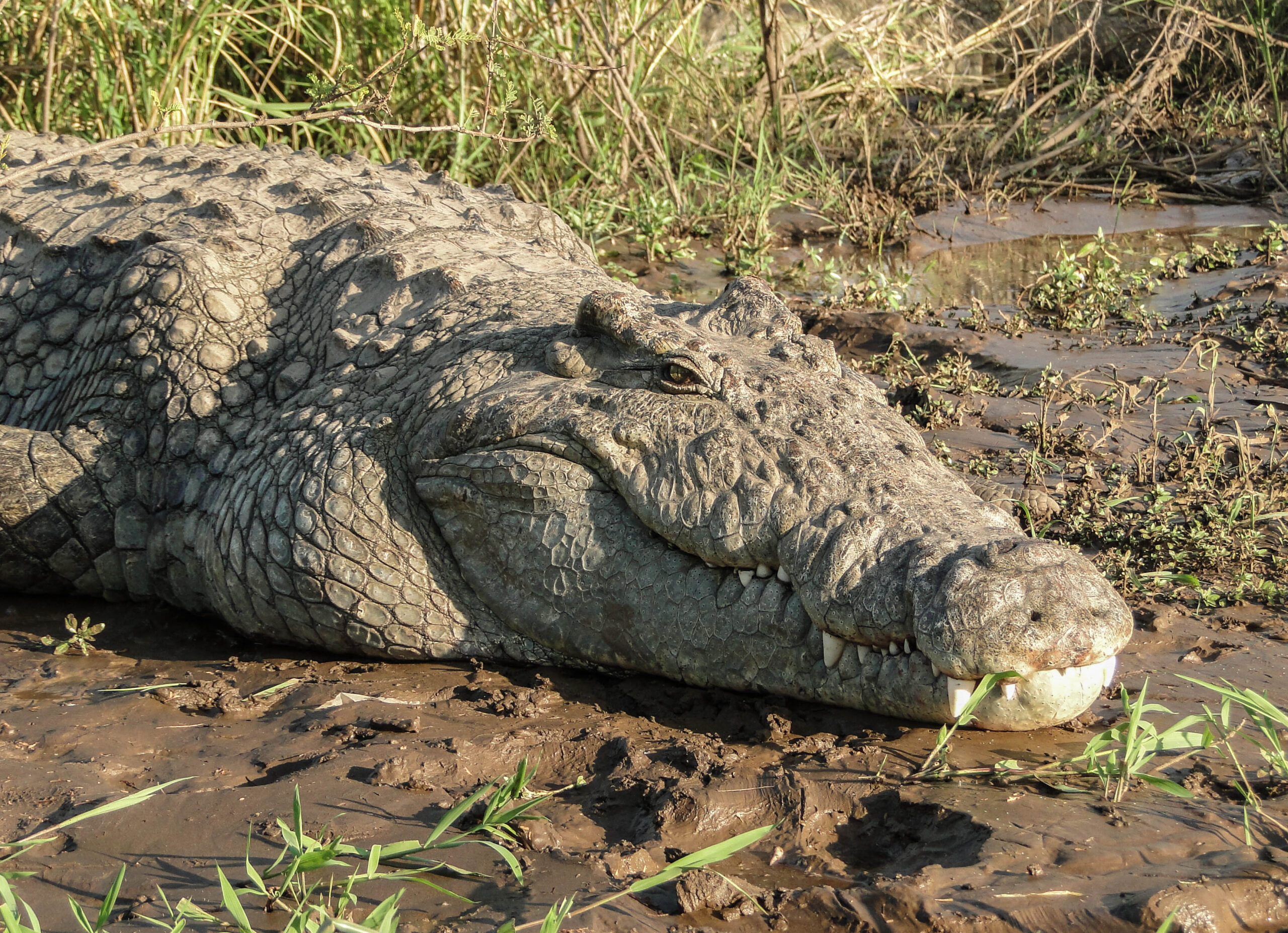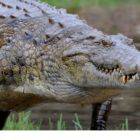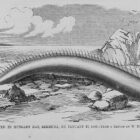Can a crocodile capsize a boat?

Picture yourself on a small boat, gently rocking with the rhythmic flow of the water. The air is filled with a sense of adventure and anticipation as you navigate through nature’s canvas. Suddenly, a shadow emerges beneath the surface – a massive crocodile.
In that moment, as you lock eyes with this ancient predator from the confines of your modest vessel, a question echoes in your mind: can that crocodile overpower a my tiny boat?
Crocodile Anatomy
Crocodiles are formidable creatures known for their impressive size and weight. They belong to the Crocodylidae family, which includes several species varying in size, such as the Nile crocodile, saltwater crocodile, and American crocodile. These reptiles can grow to substantial lengths, with some individuals reaching over 20 feet (6 meters) in length and weighing more than a ton.
Their elongated bodies are covered in tough, scaly skin that provides protection and aids in camouflaging them in their natural habitats. This skin is also an excellent insulator, helping crocodiles regulate their body temperature in various environments, from sweltering tropical waters to cooler freshwater habitats.
Crocodiles possess powerful tails that play a crucial role in their locomotion. These tails are muscular and can be used for swimming with remarkable agility and speed. When hunting or defending themselves, crocodiles rely on their tails for propulsion and maneuverability, making them efficient predators in both water and on land.
Another distinctive feature of crocodiles is their massive heads and powerful jaws. These reptiles have a robust skull structure with strong muscles that control their jaw movements. Their jaws are armed with rows of sharp, conical teeth designed for gripping, tearing, and crushing prey. The bite force of a crocodile is among the strongest in the animal kingdom, capable of exerting tremendous pressure when closing their jaws.
Crocodile Behavior
Crocodiles are apex predators, meaning they occupy the top of the food chain in their ecosystems. They are highly skilled hunters and employ a variety of tactics to catch their prey. One of their most common hunting strategies is ambush predation. Crocodiles will often lie in wait near the water’s edge, concealed by vegetation or submerged partially in the water, patiently waiting for an unsuspecting animal to approach.
When potential prey comes within striking distance, crocodiles use their lightning-fast reflexes to launch a powerful attack. They can lunge out of the water with remarkable speed and accuracy, grabbing their prey with their strong jaws and dragging it into the water. This hunting technique is highly effective and allows crocodiles to capture a wide range of prey, including fish, birds, mammals, and even other reptiles.
When it comes to interactions with boats or humans, crocodiles generally exhibit a cautious and wary demeanor. They are naturally curious animals and may investigate unfamiliar objects or disturbances in their environment. However, crocodiles are not inherently aggressive towards boats or humans unless they feel threatened or provoked.
In most cases, crocodiles will avoid confrontation and prefer to retreat rather than engage in aggressive behavior. They may display warning signs such as hissing, bellowing, or slapping their tails on the water to communicate discomfort or displeasure. These behaviors serve as a means of communication and are often a precursor to more serious threats if the perceived threat persists or escalates.
Assessing the Risk to Boats
The risk of a crocodile capsize largely depends on several factors, including the size and stability of the boat, the behavior of the crocodile, and the specific circumstances of the encounter.
Boat Size and Stability
One of the critical factors influencing the risk of a crocodile capsize is the size and stability of the boat. Smaller watercraft, such as canoes, kayaks, or rafts, are inherently more vulnerable to tipping over when subjected to external forces, including the impact of a crocodile. These boats have less surface area and may lack the stability necessary to withstand sudden movements or disturbances caused by an aggressive crocodile.
In contrast, larger boats, such as motorboats, sailboats, or ships, are typically more stable due to their size, weight, and design. These vessels are less likely to be capsized by a crocodile, especially if they are operated responsibly and maintain a safe distance from potential hazards.
A saltwater crocodile (Crocodylus porosus), the largest living reptile species in terms of mass, can grow to impressive sizes. Adult males can reach lengths of up to 5 to 7 meters (16 to 23 feet), almost two lengths of a 2-person kayak (12-13 feet) or a small canoe.
Crocodiles Are Opportunistic
Understanding the behavior of crocodiles is essential in assessing the risk they pose to boats. Crocodiles are generally opportunistic predators that target prey within their reach. While they do not perceive boats as natural prey items, they may exhibit territorial or defensive behaviors if they feel threatened or provoked.
Aggressive behavior from a crocodile towards a boat is more likely in situations where the animal perceives the vessel as a threat or an obstacle to its territory. For example, if a boat approaches too closely to a crocodile nesting site or disrupts its feeding area, the crocodile may react defensively, potentially leading to a risky encounter.
Specific Circumstances
The risk of a crocodile capsize can also vary depending on the specific circumstances of the encounter. Factors such as the presence of multiple crocodiles, the proximity to crocodile habitats, the time of day (crocodiles are more active at night), and human activities in the area can all influence the likelihood of a crocodile-related incident.
In regions where crocodiles are known to be more aggressive or where human-crocodile interactions are common, the risk to small boats may be higher. Conversely, in areas where crocodile populations are managed, and boaters adhere to safety protocols, the risk can be significantly mitigated.
Mitigating Risks and Ensuring Safety
Before embarking on any water-based activity in crocodile-inhabited areas, it’s crucial to understand the behavior patterns of these apex predators. Crocodiles are most active during certain times of the day, such as early morning, late afternoon and night, when they are often seen basking near the water’s edge or patrolling their territories. Being aware of these peak activity periods can help boaters plan their outings to minimize potential encounters with crocodiles.
Maintaining Safe Distances
Maintaining a safe distance from the water’s edge is a fundamental safety practice when boating in crocodile territory. Crocodiles are adept at camouflaging themselves along shorelines, making it challenging to spot them until they are in close proximity. Keeping a reasonable distance from the shoreline helps minimize the chances of surprising or provoking a crocodile, reducing the risk of aggressive encounters.
Boat Selection and Preparation
Opting for a sturdy and stable boat, such as a motorized vessel or a well-built kayak or canoe, provides a more secure platform for boating activities. Regular maintenance checks, including inspecting for leaks or structural weaknesses, are essential to prevent unexpected failures that could lead to dangerous situations, including capsizing.
Equipping the boat with essential safety gear is non-negotiable when boating in crocodile territory. This includes life jackets or personal flotation devices (PFDs) for all occupants, a reliable communication device such as a marine radio or a fully charged cell phone in waterproof casing, and a first-aid kit. Familiarizing oneself with emergency procedures, including how to respond to a potential crocodile encounter, can make a significant difference in handling unexpected situations effectively.










